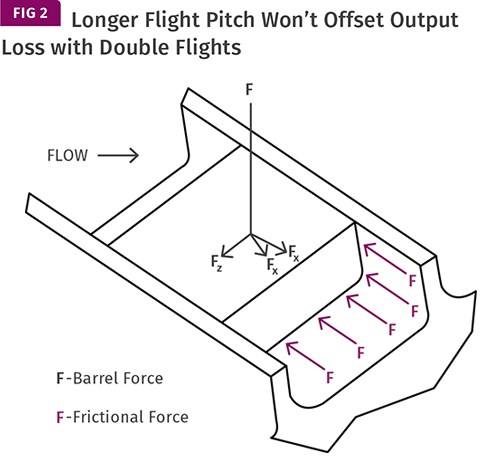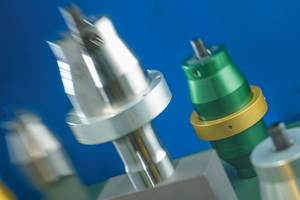EXTRUSION: Double Flights Are Not a Cure-All
There are certain applications where double-flighted feed sections make sense, and others where they don’t.
I often see double flights in the feed section of screws designed primarily for recycling. Basically, a double-flighted feed section is best used for either grooved-barrel extruders, where the extreme pressure buildup needs to be balanced around the screw, or where the screw is going to be subjected to a side load from a feeder, crammer, or stuffer, which is common in recycling applications.
Double flights provide more consistent pressure around the screw circumference and more bearing or support area for the screw. That way, the contact pressure between the screw and barrel is reduced, thereby relieving the condition where adhesive wear can occur. Under adhesive wear conditions, the screw flight and the barrel surface are forced together with such pressure that the sliding friction becomes so great the surfaces actually gall or fuse, causing catastrophic screw/barrel wear.
With gravity feed in a smooth-bore extruder—where there is no mechanism to develop such high side pressure in the solids feed—the double flights will actually reduce the feed capacity at the same pitch and depth. For one thing, the additional flight takes up some of the channel space and presents an obstruction to the screw filling, as there is always a flight partially blocking the feed opening. This could be particularly restrictive for materials that are not free-flowing, like much recycle feedstock.
But probably more important is the additional screw surface area that the polymer must slide on to move down the screw. The basic premise is that the polymer must stick to the barrel more than it sticks to the screw in the solids feed area in order to move down the screw. It’s then expected that if the surface area of the screw is significantly increased due to the addition of the second flight, while there is a fixed area for the barrel, the feed rate will be reduced against the same down-channel pressure.
Making adjustments to offset that output lost due to the additional flight—such as designing a longer flight pitch or deeper channels to increase the volume of solids—is not a straightforward solution. The use of a longer pitch increases the cross-channel force and in turn increases the frictional coefficient of the solids against the screw surface.
The cross-channel component of the moving force, F (barrel rotation relative to the screw), shown as Fz in Fig. 2, increases as the flight pitch increases; while the down-channel component, Fx , is reduced proportionally. The frictional coefficient is proportional to the pressure or normal force, in this case Fz. This then increases the drag of the solids on the screw surface, indicated by the purple frictional forces, which impede the solids movement and offset the effects of the wider channel.
Deepening the channel also may not be as much of an offset as one would expect. A force balance on the solid resin shows the conveying efficiency decreasing as channel depth increases. This is due to greater particle slippage of the solids, causing a reduction in the average velocity of the solid bed with increasing depth. Reducing the flight widths to offset the reduction in channel volume due to the addition of the second flight has almost no effect, as that volume change is very small compared with the effect of the change in screw surface area. Mechanical and manufacturing limitations usually restrict how much the flight width can be reduced anyway.
Given these potential negative effects of double flights in the solids feed area, I suspect that the inherent advantages of double flights in the melting and venting sections precipitated their use. Because of uncertainty about how and where to start them after the feed section they are simply being extended backward into the feed section.
This whole analysis is greatly complicated by the changing frictional coefficients with temperature and the polymer particle characteristics affecting compaction. Also, frictional coefficients vary widely for the same polymer, so data is hard to come by. Finally, solids velocity and a force balance are undefined until compaction occurs, and that is also hard to define.
This means feed-section design still depends a lot on empirical data. However, the relationships noted above generally hold. So proceed with caution if you are looking to specify a screw with double flights in the feed.
Related Content
The Importance of Barrel Heat and Melt Temperature
Barrel temperature may impact melting in the case of very small extruders running very slowly. Otherwise, melting is mainly the result of shear heating of the polymer.
Read MorePlastics Technology Year in Review: Your Favorite Reads of 2024
A year-end review of the top stories showcasing industry trends, advancements and expert insights. Revisit the articles that captured the attention of the plastics community.
Read MoreMedical Tubing: Use Simulation to Troubleshoot, Optimize Processing & Dies
Extrusion simulations can be useful in anticipating issues and running “what-if” scenarios to size extruders and design dies for extrusion projects. It should be used at early stages of any project to avoid trial and error and remaking tooling.
Read MoreUltrasonic Welding: Tips, Techniques, and Troubleshooting
In this collection of content, we provide expert advice on welding from some of the leading authorities in the field, with tips on such matters as controls, as well as insights on how to solve common problems in welding.
Read MoreRead Next
People 4.0 – How to Get Buy-In from Your Staff for Industry 4.0 Systems
Implementing a production monitoring system as the foundation of a ‘smart factory’ is about integrating people with new technology as much as it is about integrating machines and computers. Here are tips from a company that has gone through the process.
Read MoreBeyond Prototypes: 8 Ways the Plastics Industry Is Using 3D Printing
Plastics processors are finding applications for 3D printing around the plant and across the supply chain. Here are 8 examples to look for at NPE2024.
Read MoreLead the Conversation, Change the Conversation
Coverage of single-use plastics can be both misleading and demoralizing. Here are 10 tips for changing the perception of the plastics industry at your company and in your community.
Read More
.jpg;width=70;height=70;mode=crop)























